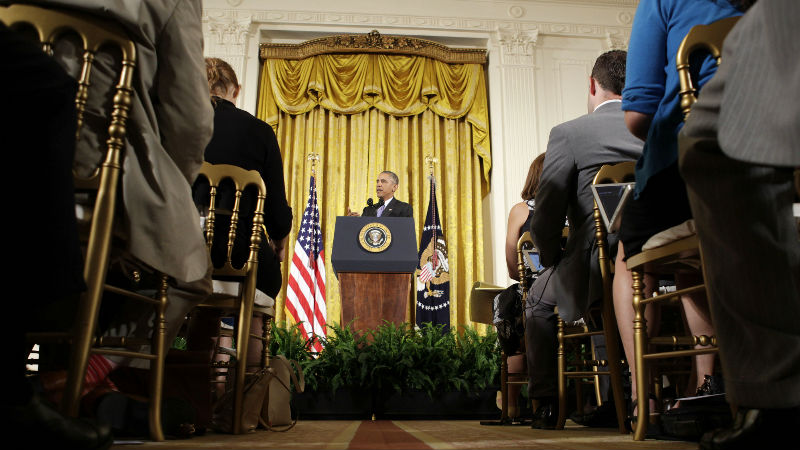
In this July 15, 2015, photo, President Barack Obama answers questions about the Iran nuclear deal during a news conference in the East Room of the White House in Washington. Obama is holding on to relatively high levels of support among the so-called “Obama coalition” of minorities, liberals and young Americans, suggesting the president could play a potent role helping the next Democratic presidential nominee’s bid for election, an Associated Press-GfK poll found. (AP Photo/Pablo Martinez Monsivais)
WASHINGTON — Barack Obama is holding on to relatively high levels of support among the so-called “Obama coalition” of minorities, liberals and young Americans, suggesting the president could play a potent role helping the next Democratic presidential nominee’s bid for election, an Associated Press-GfK poll found.
Yet even with that support from his core supporters, less than half the public has a positive view of his presidency.
Hillary Rodham Clinton, the party front-runner in the 2016 presidential campaign, is viewed somewhat less favorably by the key voting groups whose record-setting turnout in 2008 propelled Obama to the White House.
Roughly two-thirds of Hispanics view Obama favorably, compared to just over half of Hispanics who say the same about Clinton. Among self-identified liberals, Obama’s favorability stands at 87 percent, to Clinton’s 72 percent. Half of Americans under the age of 30 view Obama favorably, compared to just 38 percent for his former secretary of state.
The findings offer a window into the factors at play as Clinton decides how closely to embrace Obama, his record and his policies in her campaign for president. Although associating herself with Obama could turn off some independent and Republican-leaning voters, electoral math and changing demographics make it critical for Democrats to turn out high numbers of Hispanics, African Americans and young voters.
Overall, Obama’s job approval rating stands at 43 percent, a leveling off following an AP-GfK poll conducted in early February that put his approval at 47 percent — slightly higher than it had been through most of 2014. The number of Americans who disapprove of Obama’s job performance has stayed relatively steady at 55 percent.
“He just seems to have something in his mind that he wants to accomplish and keeps trying to get it done,” said Christine Klauder, a self-described liberal from southern New Jersey. Klauder said she voted for Obama in 2008 and 2012 and said her support hasn’t dropped off. “He’s more oriented toward the kind of people that I feel that we are, have been all my life.”
Contrast that with Klauder’s views about Clinton, who has yet to win her enthusiastic support. “Being a woman, I think it would be wonderful to see her in — but I’m not sure,” Klauder said. “I think maybe her time has passed.”
Obama, whose troubles in the polls were seen as a drag on Democratic in last year’s midterm elections, has also managed to hold on to recent gains he’s made among core supporters.
When AP-GfK polled in October 2014, Obama’s approval rating among Hispanics had plummeted to 39 percent, as Hispanic advocacy groups demanded that Obama take aggressive action on immigration. One month later, he did just that — and his job approval among Hispanics now stands at 56 percent. Whereas 72 percent of liberals approved of Obama’s performance in October, that number now appears to have climbed, to 82 percent.
The survey reinforces a concern expressed by many Democrats about Clinton’s candidacy: that she just doesn’t inspire the levels of enthusiasm among traditional Democratic constituencies that were so critical to Obama’s success.
In the first weeks of her campaign, Clinton has promoted a number of populist ideas surrounding immigration, voting rights and economics that hew closely to themes that Obama has made central to his presidency. Although she distanced herself from Obama by suggesting she would have voted against giving Obama expedited authority to negotiate trade deals, she offered explicit support for the controversial nuclear deal with Iran that Obama announced this week.
In an AP-GfK poll conducted in January and February, nearly half of Americans — 47 percent — described the economy as “good,” almost as many as the 51 percent who called it “poor.” Since then, views of the economy have grown slightly more negative, with 41 percent now saying the economy is “good” and 57 percent saying it’s “poor.”
___
The AP-GfK Poll of 1,004 adults was conducted online from Thursday to Monday, using a sample drawn from GfK’s probability-based KnowledgePanel, which is designed to be representative of the U.S. population. The margin of sampling error for all respondents is plus or minus 3.4 percentage points, but higher for subgroups such as Hispanics and African Americans.